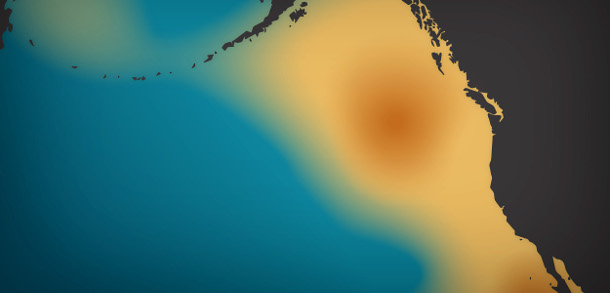[Editor’s note: This article is from Hakai Magazine, an online publication about science and society in coastal ecosystems. Read more stories like this at HakaiMagazine.com.]
The Blob helped create the bloom.
Beginning in the fall of 2013, “the Blob” has sat off the Pacific Coast of North America. This massive swathe of abnormally warm water raised the average temperature of the sea by 2.5 degrees Celsius and is thought to have thrown the marine ecosystem for a massive loop.
Throughout its run, scientists speculated that the Blob was responsible for a whole host of damages, from mass bleaching of Hawai’ian coral and irregular fish migration, to sea lion beachings, and warmer seasons.
Now, researchers following up on the Blob have confirmed the proposed connection between it and another abnormal event: a massive 2015 algae bloom that hit the eastern Pacific with the largest outbreak of toxic domoic acid-producing algae ever recorded in the region. Domoic acid is the neurotoxin responsible for the widespread marine mammal strandings and the closures of shellfish fisheries along the west coast last year.
The research not only confirms the suspicions that the two anomalies were connected, it hints at what the future may look like as the ocean warms.
According to Ryan McCabe, a physical oceanographer at the University of Washington and the lead author on the report, the Blob was not solely responsible for causing the 2015 bloom, but it was a key catalyst.
The Blob caused the water in the eastern Pacific Ocean to be both warm and low in nutrients, “conditions that are ripe for toxin production,” says McCabe. “Anything that will give rise to those types of conditions in the future we should be a bit wary of.”
The Blob was helped by a series of powerful storms in the spring of 2015 that concentrated toxin-producing algae near the coast.
Ultimately, the algae bloom was triggered by the seasonal upwelling of nutrient-rich waters from deeper in the ocean. But it was the difficult conditions created by the Blob that made the bloom more dangerous, says McCabe. Pseudo-nitzschia australis, the algae species behind the bloom, is adapted for warm, low-nutrient waters and took hold in the conditions set by the Blob.
“It was a perfect storm, so to speak, because it did require a series of events to take place,” McCabe says. “You have to have these conditions out there that provide good growing conditions, and yet some sort of stress, because a lot of studies have shown that toxin production by these species is related to nutrient stress in some form or fashion.”
P. australis often blooms seasonally in spots along the U.S. west coast, but this was the first time the species had been observed in such vast numbers along the entire American and Canadian coastlines.
More extreme algae blooms may be inevitable in the future, but knowing how warm water contributes to toxin production may help coastal communities prepare.
McCabe says scientists can’t forecast exactly how toxic algae blooms will change in the future, but “if you do get warm, low-nutrient waters, well, just beware.” ![]()
Read more: Environment
















Tyee Commenting Guidelines
Comments that violate guidelines risk being deleted, and violations may result in a temporary or permanent user ban. Maintain the spirit of good conversation to stay in the discussion.
*Please note The Tyee is not a forum for spreading misinformation about COVID-19, denying its existence or minimizing its risk to public health.
Do:
Do not: